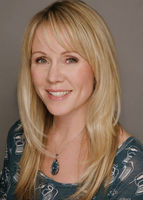"Be Patient...and Develop a Thick Skin" Deborah Kerbel on Literary Events, Breaking into Picture Books, & Cover Reveals
In 1923, 32-year old Frederick Banting received the Nobel Prize for Medicine, remaining to this day the youngest Nobel laureate in his category. His contribution, now one of the most well-known medical research triumphs in history, was the discovery of insulin and its ability to control diabetes.
Banting shared the prize with John MacLeod (as well as voluntarily splitting his portion of the prize money with his assistant, Charles Best), but there was another important contributor to his discovery: Banting's favourite test dog, a stray named Marjorie. It was Marjorie who responded positively to the insulin treatment, prompting it to be tested in human subjects, at which point it was deemed a medical miracle.
Deborah Kerbel's Fred & Marjorie: A Doctor, a Dog, and the Discovery of Insulin (Owlkids, illustrated by Angela Poon) follows Banting's discovery and his bond with Marjorie in a kid-friendly graphic novel form, while also engaging with issues around the use of animals in medical research.
We're excited to welcome Deborah to Open Book to celebrate the publication of Fred & Marjorie. Today she takes our Going Pros and Cons challenge, where we ask writers to share a behind the scenes glimpse of their life in the world of writing and publishing.
Deborah shares her advice for emerging writers, reveals her favourite part of the publishing process, and tells us about and the two essential elements of a writing space.
Going Pros and Cons with Deborah Kerbel:
My best public reading or event experience:
Ah... public book events. At this point, they seem like a relic from another era. I’ve truly enjoyed them all, but I think the Wordfest Festival in Calgary stands out as a favourite because, when it was over, all the presenters were invited to stay on for a five-day writing retreat at the beautiful Banff Centre for the Arts. Although truthfully, most of the creators I retreated with (myself included) were too in awe of the incredible scenery to get much writing done.
My worst public reading or event experience:
The night I was asked to be a guest speaker at a CANSCAIP meeting and, on the way to the venue, found myself (along with fellow writer Marina Cohen) in the middle of a police take-down. One minute we were minding our own business walking south on Yonge Street, the next there were cops everywhere, guns drawn, people fleeing. We ducked and ran for cover and luckily made it to the venue — rattled but unscathed. The upside? We got some first-hand dramatic material to use for our next books!
My most awkward writing/publishing moment:
Just one? Hmmm...probably the time I was asked to lead a book club for one of my YA novels, but on the night of the event Toronto was hit with a freak snowstorm. I plowed my way to the book store venue only to discover that just one reader had made it through the storm. We carried on with the event, and it was pretty awkward – probably for both of us. But is a writer ever officially a ‘real’ author if they’ve never had a signing/launch/reading/event bomb?
A writer whose career I admire and why:
Mahtab Narsimhan is a kid lit rockstar, an incredibly disciplined writer, and successful in a bunch of different genres. She’s generous and supportive to her writing community and always learning new skills and improving her craft. Plus, she cooks the most delicious Indian feasts. I want to be her when I grow up.
The advice I would give someone publishing a book for the first time:
Once your word baby hits the bookshelves, it doesn’t belong to you anymore. It belongs to the readers. You can no longer change it or control what happens to it (especially not how it’s received and reviewed) so take a deep breath and just let it go.
Your CanLit News
Subscribe to Open Book’s newsletter to get local book events, literary content, writing tips, and more in your inbox
The advice I would give someone trying to get a book published for the first time:
Be patient. Publishing is an agonizingly slow industry. And one of the toughest to break into. So, do your research and go in with your eyes wide open. If you want to write a picture book, try to manage your expectations. They’re probably the hardest genre of book to sell to publishers. Oh yeah, and develop a thick skin while you’re at it. Even established writers get lots of rejections.
My favourite part of the publishing process:
Hands down, the cover reveal. It’s always a thrill seeing someone else’s interpretation of the story and characters that sprang from your imagination. True story: when my editor emailed me the cover of my first published novel, I was so giddy with excitement I printed it and put it beside my pillow when I went to sleep that night. I wanted it to be the first thing I saw when I opened my eyes the next morning.
Book nerds gonna book nerd.
My least favourite part of the publishing process:
The hurry-up-and-waiting is emotionally exhausting. But I’ve made peace with the fact that it’s part of the business. Also, bad reviews always suck.
The thing(s) I need at/in my writing space:
A hot drink and a closed door.
___________________________________________________________
Deborah Kerbel is an award-winning author who writes young adult and middle grade novels, as well as picture books and nonfiction. She lives and writes in Thornhill, Ontario, with her husband, two teens, and a rescue schnoodle named Freddie.




